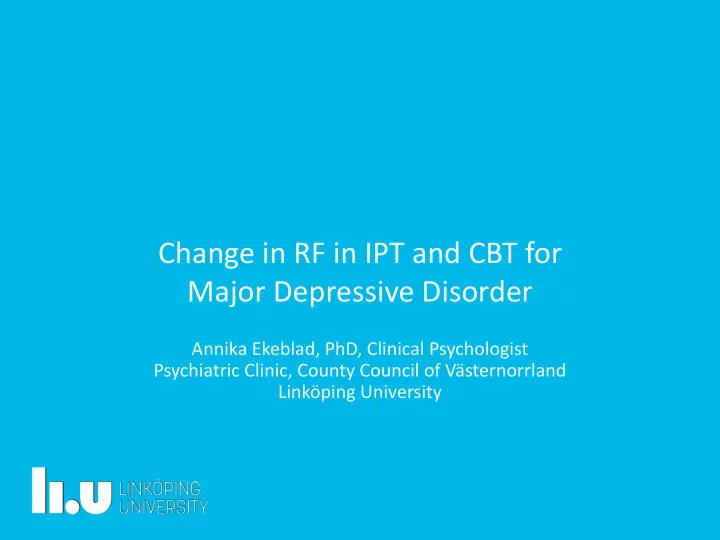

Change in RF in IPT and CBT for Major Depressive Disorder Annika Ekeblad, PhD, Clinical Psychologist Psychiatric Clinic, County Council of Västernorrland Linköping University
Background: The CIPPS project, Psychiatric 2 Clinic, Sundsvall, Sweden
Aims 3 • Compare treatment outcome between CBT and IPT in MDD • Study the significance of a potential moderator variable, mentalization • Study potential changes in the level of mentalization
Background: Mentalization and RF 4 • Mentalization : understanding that mental states underlie behavior – Operationalization: Reflective function (RF); Depression-specific RF (DSRF); adaptation to depression • RF low in patients with MDD ; Unclear if cause or effect (or third factor?)
Key questions: Mentalization and RF 5 • RF changed by treatment or co-varies with depression symptoms? • Do different treatment approaches influence RF differently?
Study design 8 Assessed for eligibility (n= 99) Excluded (n=3) - Declined to participate (n=3) • not randomization (n=1) • not video (n=2) Randomized • RCT of IPT vs CBT in MDD (n= 96) • 96 patients included • Few exclusion criteria IPT (n=48; 33 women, 15 men) CBT (n=48; 33 women, 15 men) • Did not start therapy • Did not start therapy Allocation (n=5; women) (n=1; woman) • Started therapy (n=43) • Started therapy (n=47) • Satisfactory adherence to treatment models Drop outs (n=8) (4 women, 4 Drop outs (n=19) (13 women, 6 men) men) Drop-outs Completers (n=35; 24 women, 11 Completers (n=28; 19 women, 9 men) men) Completers
Method: Outcome assessments, 7 predictors and moderators • Primary outcome • Predictors / moderators measure – RF – BDI-II – DSRF • Secondary outcome measures – RF – DSRF – RTW – Drop-out rate
Method: RF assessment • Abbreviated form of AAI (Adult Attachment Interview); rated with RF scale • Depression-specific RF scale (DSRF)
Depression Specific Reflective Functioning 9 DSRF • Interview developed by Fredrik Falkenström Linköping/Stockholm Sweden after Panic specific reflective functioning (PSRF) Barbara Milrod
Depression Specific Reflective Functioning 10 DSRF Interwiev: -Why do you think you are depressed -Did your thoughts about why you are depressed change over time? -Have you ever noticed that you become more depressed by certain events, thoughts or feelings?
RF scale 11 • Rated from transcriptions of Adult Attachment Interwievs • Scale: -1 to 9 from anti-mentalizing to highly reflective • Theoretical ”normal” level is 5
Results: Outcome trajectories 12
Results: Mentalization 13 13 RF as a predictor: • Pre-treatment RF predicted: – treatment results – alliance • No difference between treatment methods RF and DSRF levels: • RF increased during IPT treatment (and not in CBT) • RF after treatment was still low in depressed patients • DSRF did not change over treatment (but significant decrease in DSRF at session 5)
RF and DSRF predicting change in depression severity
Change in RF from pre- to post treatment 15 15 • Used only patients who completed treatment (N = 63) – 56 AAI interviews before treatment – 44 AAI interviews after treatment • Average pre-post difference 0.32 ( t (40) = 2.16, p = .04) • Correlation between change in RF and change in BDI-II: r = .11 (ns)
Change in RF from pre- to post treatment 16 16 • Difference in pre-post change between treatments statistically significant ( F (1, 39) = 6.08, p = .02) • CBT (N = 18): Pre RF = 2.89, Post RF = 2.92 • IPT (N = 24): Pre RF = 2.67, Post RF = 3.27
Change in DSRF from pre- to post 17 17 treatment • Used only patients who completed treatment (N = 63) – 53 DSRF interviews before treatment – 45 DSRF interviews after treatment • Average change from pre- to post non- significant • Difference between treatments in pre- to post change non-significant
Clinical implications 18 18 Potential clinical implications: • Supports the value of CBT and IPT for severely depressed patients • Drop-outs from CBT • Select depressed patients for CBT that are motivated • Important to offer different forms of therapy • Patients with poor capacity for mentalization not good candidates for these treatments • IPT contributed to an increase in RF - but did not result in a normal RF level; make efforts to adapt IPT for the purpose of increasing RF?
19 Limitations • Large rate of attrition • Compensated to some degree by multiple imputation
Thank you for listening! annika.ekeblad@lvn.se www.liu.se
Recommend
More recommend